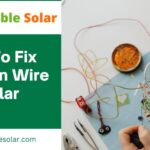How to Connect Solar Inverter to Breaker Box: The Ultimate Guide
To ensure a safe and efficient connection, you must take precise actions on How to Connect the Solar Inverter to the Breaker Box. A critical step in constructing a solar power system is connecting a solar inverter to a breaker box.
The breaker box, often known as the electrical panel, is in charge of delivering power throughout your home or business. When the solar inverter is properly connected to the breaker box, you can use the generated solar energy, minimizing your reliance on the grid and perhaps saving money on energy bills.
We will go over the procedure of connecting a solar inverter to a breaker box step by step, giving you the confidence to do it yourself or understand the requirements if you prefer to hire a professional. By mastering this procedure, you will be able to optimize the benefits of your solar power system. So, let’s get started!
Understanding The Solar Inverter And Breaker Box
When it comes to connecting your solar power system to your home’s electrical system, understanding the solar inverter and breaker box is critical. In this blog post, we’ll go over what a solar inverter and breaker box are, as well as their responsibilities and significance in solar power setups.
What exactly is a solar inverter?
A solar inverter, often known as a PV inverter, is an important part of a solar power system. Its main job is to change the direct current (DC) electricity that solar panels produce into alternating current (AC) electricity that can power the electronics and appliances in your home.
When sunlight strikes the solar panels, DC electricity is generated. However, most domestic appliances and the power system run on alternating current (AC). The solar inverter comes into play here. It converts DC electricity into AC electricity, allowing you to use it in your home and take advantage of the solar energy you generate.
What exactly is a breaker box?
A breaker box, also known as an electrical panel or distribution board, is an essential component of any electrical system, including solar panels. It serves as a central hub for distributing electricity from multiple sources throughout your home.
Circuit breakers, which are switches that protect your home’s electrical system from overloading and electrical surges, are installed in the breaker box. In the event of a short circuit or overload, these circuit breakers automatically cut off the flow of electricity, preventing damage to your electrical devices and lowering the risk of electrical fires.
A Solar Inverter’s Role in a Solar Power System
In a solar power system, the solar inverter is critical. It maximizes the solar panels’ energy output while also converting the DC electricity the sun generates into AC electricity, offering the highest level of performance and efficiency. Furthermore, some powerful solar inverters include monitoring features, allowing you to track your solar power generation and energy use.
A Breaker Box’s Importance in Solar Power Installations
The breaker box is an important part of any solar power installation because it ensures the safe and efficient distribution of electricity throughout your home. It enables the correct connection and integration of your solar power system with your home’s current electrical system. Furthermore, the circuit breakers in the breaker box protect your electrical gadgets and prevent any potential electrical problems.
To guarantee a safe and compliant installation, it is critical to adhere to local electrical laws and regulations when connecting a solar inverter to a breaker box. Proper installation by a skilled electrician is critical to ensuring the proper operation of your solar power system.
Planning and preparation:
Proper planning and preparation are required before connecting a solar inverter to your breaker box. This enables a seamless installation process and increases your solar system’s effectiveness. In this section, we’ll go through the essential processes for efficient planning and preparation.
Evaluating Electrical Load Needs
Begin by assessing your household or business’s electricity load requirements. This entails calculating how much electricity you use on a daily basis. Consider the number of appliances, lights, and electronic devices in use, as well as any prospective growth in energy usage. Consult your electric bills and record the average kilowatt-hours (kWh) utilized each month to accurately calculate your load requirements.
Choosing the Correct Solar Inverter for Your System
The selection of the appropriate solar inverter is critical to the success of your solar project. String inverters, microinverters, and power optimizers are among the several types of inverters available. Investigate each choice and think about things like efficiency, dependability, and compatibility with your solar panels and electrical infrastructure. Check to see if the inverter has features like anti-islanding prevention, monitoring capabilities, and grid connectivity.
Choosing the Best Location for the Breaker Box
The location of your breaker box is critical for properly connecting the solar inverter. The breaker box should ideally be conveniently accessible, well-ventilated, and located close to the point of hookup. To ensure a safe and convenient installation, make sure the area around the breaker box is clear of obstructions. Consult a professional electrician if necessary to identify the best location for your breaker box.
Evaluating the Electrical Panel’s Capacity
It is critical to examine your existing electrical panel’s capacity to handle the solar inverter installation. The replacement circuit breaker required for the inverter connection should be able to fit in the breaker box. Subtract the present electrical load from the total panel capacity to determine the available panel capacity. This will assist you in determining whether any panel upgrades or alterations are required.
You will be well-prepared to connect your solar inverter to the breaker box if you follow these steps throughout the planning and preparation process. Your solar system will efficiently convert sunshine into power and contribute to a more sustainable future if it is thoroughly evaluated and properly selected.
Taking safety measures:
When connecting a solar inverter to a breaker box, safety should always come first. If the installation is not done correctly, there is a significant risk of electric shock and fire. It is critical to take the necessary safety precautions to protect yourself and your possessions. In this section, we will go through the critical procedures you must take to ensure a safe and successful installation.
Learn about your local electrical codes and regulations.
Before beginning any electrical work, it is critical that you become acquainted with the local electrical codes and laws in your area. These codes and regulations differ by location and are implemented to safeguard the safety of the electrical system. Before you begin the installation procedure, make sure you understand all of the instructions and criteria. This will assist you in avoiding infractions and keeping your installation up to code.
Powering Down the Electrical Panel
You must turn off the power to the electrical panel before connecting the solar inverter to the breaker box. This is an important step since it assures that no power is flowing through the circuit while you are working on the wiring. Locate the main breaker switch or disconnect switch and turn it off to disconnect the power. Remember that electricity is extremely dangerous and can cause significant harm, so make sure the power is turned off before installing.
Wearing Protective Equipment and Taking Precautions
When working with electrical systems, wearing the proper safety equipment and taking all required precautions to protect oneself from potential hazards is critical. Wearing safety gloves, eyewear, and non-conductive footwear is part of this. Also, make sure the work area is well-ventilated and clear of moisture or water. Taking these precautions will dramatically reduce the likelihood of an accident or injury during the installation procedure.
Grounding the Solar Inverter and Circuit Breaker
Grounding is an important step in any electrical installation, and connecting a solar inverter to a breaker box is no exception. Proper grounding guarantees that any unexpected electrical surges or faults are securely routed into the ground instead of harming the equipment or endangering the users. Refer to the manufacturer’s instructions or a certified electrician for the correct grounding of the solar inverter and breaker box. This step should not be missed because it is critical to the safety and reliability of your solar power system.
Connecting the solar Inverter:
It is critical to follow a step-by-step approach when connecting a solar inverter to a breaker box to ensure a safe and successful connection. This section will lead you through the process of connecting the solar inverter to the breaker box, beginning with properly installing the inverter, wiring it to the breaker box, and ultimately connecting the DC and AC lines.
Properly Mounting the Solar Inverter
To begin, it is critical to secure the solar inverter in an acceptable area. Check that the mounting surface is strong enough to support the weight of the inverter. To reduce cable length and the risk of potential damage, it is advised that the solar inverter be mounted indoors, ideally near the breaker box. The ideal approach is to mount the inverter on a wall or a structured rack.
How to Connect the Solar Inverter to the Breaker Box
After the solar inverter has been firmly installed, the next step is to connect it to the breaker box. To avoid any electrical risks, begin by shutting off the main power supply to the breaker box. Connect the inverter’s DC and AC terminals to the relevant terminals in the breaker box using the appropriate cables. It is critical to follow the manufacturer’s recommendations and verify that the cables are properly sized and rated for the power output of the inverter.
Connecting the DC and AC Wires Correctly
It is critical to follow the polarity and color-coding requirements while connecting the DC and AC connections. The positive DC wire is often red, whereas the negative is black. AC cables, on the other hand, are usually color-coded as black for hot, white for neutral, and green or bare for ground. To build dependable connections, ensure that the wires are firmly attached and that appropriate connectors, such as wire nuts or terminal blocks, are used.
Checking for Correct Wiring
After finishing the wiring, it is critical to double-check the connections before turning on the power. Check the tightness of each wire and fasten it as needed. Inspect the breaker box and inverter for evidence of damage or loose connections as well. A thorough inspection assures the safety and proper operation of the system and aids in the prevention of electrical accidents or system failures.
Setting up the Breaker Box:
Setting up the breaker box is an important step in connecting a solar inverter to your home’s electrical system. This includes attaching the solar breaker to the breaker box, designating the correct amperage for the solar breaker, and labeling and marking the solar breaker properly for easy identification. You can ensure a safe and efficient connection of your solar inverter to the breaker box by following these instructions.
Incorporating the Solar Breaker into the Breaker Box
To start configuring the breaker box for your solar inverter, add the solar breaker. This breaker is specifically intended to connect your solar panels to the electrical system of your home. Here’s how to go about it:
- Locate an open slot in the breaker box where the solar breaker can be installed.
- Make sure the breaker box is turned off to avoid electrical shocks.
- Carefully remove the breaker box’s cover to allow access to the interior.
- Align the solar breaker in the desired slot, ensuring that it is securely in place and suitable for the breaker box design.
- Firmly press the solar breaker into place until it snaps into place.
- Replace the breaker box cover, making sure it is securely fastened to safeguard the electrical components inside.
Choosing the Right Amperage for the Solar Breaker
It is critical to assign the appropriate amperage to the solar breaker in order to avoid overloads and ensure the safe operation of your solar inverter. To find the correct amperage for your solar breaker, follow these steps:
- Determine the recommended amperage rating for your solar inverter by consulting the manufacturer’s specs.
- Check the amperage capacity of your breaker box to ensure it can accommodate the solar breaker’s required amperage.
- Consult a professional electrician if necessary to help determine the appropriate amperage distribution and make any necessary changes to your breaker box.
Proper Solar Breaker Labeling and Marking
The solar breaker must be properly labeled and marked for simple identification and maintenance. This makes it possible for anyone working with the breaker box to readily identify the solar breaker. The following are some suggestions:
- Label the solar breaker with a clear and succinct indication that it is linked to the solar inverter using a permanent marker.
- Mark the solar breaker with a colored sticker or tag to identify it from the other breakers in the breaker box.
- Include the solar breaker’s position and purpose in a breaker box diagram or electrical panel schedule.
You may ensure a smooth and safe connection of your solar inverter to your home’s electrical system by carefully wiring the breaker box, installing the solar breaker, allocating the required amperage, and properly identifying and marking it.
Testing and commissioning:
When connecting a solar inverter to the breaker box, the testing and commissioning phases are crucial. This verifies that the system is operational and capable of producing power effectively. You can assure the reliability and safety of the solar installation by running a number of tests and verifications.
Putting the Solar Inverter and Breaker Box to the Test
A functional test of the solar inverter and breaker box is one of the initial phases in the testing and commissioning process. This test entails inspecting the wiring connections to ensure that all components are securely linked and connected. To guarantee that the installation meets the needed requirements, it is critical to follow the manufacturer’s instructions.
Verifying the Solar Panels’ Power Generation
Following the functional test, the solar panels’ electricity generation must be verified. This entails inspecting the output of the solar panels to ensure that they are producing the desired amount of power. You may measure the voltage and current produced by the solar panels by connecting a multimeter or using monitoring software. This process ensures that the panels are performing properly and producing the most energy possible.
Ensure that the circuit breakers work properly.
Another critical component of testing and commissioning is ensuring that the circuit breakers work properly. These breakers safeguard the system against overcurrent and short circuits. You can guarantee that each breaker trips when necessary and provides the necessary protection by testing it. It is critical to ensure that the amperage rating of the breakers corresponds to the system capacity. This will keep any potential damage from overload or electrical failures at bay.
System Activation and Performance Monitoring
When all of the required tests and verifications have been done, it is time to power the system and monitor its operation. This entails turning on the solar inverter and measuring the output power. You may track energy production and confirm that the system is working as planned by utilizing monitoring software or a power meter. Regular monitoring allows you to spot any difficulties or variations from expected performance and, if necessary, take corrective action.
Connecting a solar inverter to the breaker box requires testing and commissioning. You can ensure the dependability, safety, and best performance of your solar system by following the appropriate protocols and completing extensive tests.
Troubleshooting and Upkeep:
Proper troubleshooting and maintenance of the solar inverter-to-breaker box connection are critical for guaranteeing optimal performance and energy generation from your solar energy system. You may reduce potential difficulties and keep your solar inverter and breaker box connections in top shape by knowing typical concerns and their remedies, examining and maintaining your system on a regular basis, and following troubleshooting recommendations. In this section, we’ll look at the most prevalent problems, best practices for maintenance, and troubleshooting techniques to help you create a smooth and efficient connection.
Common Solar Inverter to Breaker Box Connection Issues and Solutions
Several complications may emerge when connecting your solar inverter to the breaker box. You can efficiently diagnose and address these difficulties if you are aware of them and their potential solutions:
1. Incorrect wiring connections: Double-check that all wiring connections between the solar inverter and the breaker box are properly completed. Verify the polarity of the connections and double-check the wiring diagrams given by the manufacturer.
2. Overcurrent or short-circuit problems: Look for any loose connections or damaged wires if you have an overcurrent or short-circuit problem. Examine the circuit breakers and fuses for evidence of wear or tripping. Replace faulty components as needed or seek professional assistance.
3. Grounding issues: Improper grounding can pose a risk to one’s safety. Check that the ground connections are secure and that the grounding system complies with the electrical code. If you are unsure about the grounding configuration, consult an electrician.
4. Problems with communication between the inverter and the breaker box: Examine the communication connections that connect the inverter to the breaker box. Check to make sure the connections are secure and there are no signs of damage. Restart the communication system to see whether the problem remains.
System Inspection and Maintenance on a Regular Basis
For an optimum solar inverter-to-breaker box connection, regular inspection and maintenance are required. You can recognize possible concerns and avoid serious problems by following these practices:
1. Examine all wiring connections for wear, corrosion, or loose connections. Make sure everything is securely fastened, and fix any frayed or broken cords.
2. Remove dust and debris from the solar inverter and breaker box on a regular basis to improve system efficiency.
3. Examine the circuit breakers and fuses for evidence of wear or tripping. If required, replace the faulty components.
4. Use the manufacturer-supplied monitoring system or software to frequently monitor the inverter’s functioning. Keep an eye out for any anomalies or irregularities in energy generation.
Tips for Troubleshooting Faulty Connections
Before contacting a professional, consider the following troubleshooting suggestions for your solar inverter-to-breaker box connection:
1. Restart the system by switching off the inverter, waiting a few minutes, and then switching it back on. This easy technique can help overcome minor communication or software issues.
2. Check to make sure the inverter is receiving the correct DC input voltage from the solar panels. Check the output voltage of the PV array to confirm it fits the manufacturer’s standards.
3. Check for any weak wire connections in the system. If necessary, tighten them and retest the system.
4. If the problem persists, review the manufacturer’s troubleshooting guide or contact their technical support.
In the event of a Complex Problem, Consult a Professional
Complex complications with the solar inverter-to-breaker box connection may necessitate professional assistance in some circumstances. If you’re unsure or unable to address the problem on your own, call a competent electrician or the manufacturer’s technical support staff. They have the knowledge and expertise to diagnose and resolve complicated problems.
FAQs Regarding How To Connect A Solar Inverter To A Breaker Box
How Should an Inverter Be Connected to a Breaker?
These steps should be followed to connect an inverter to a breaker: 1. Disconnect the main power source. 2. Join the positive wire of the inverter to the positive terminal of the breaker. 3. Join the negative wire of the inverter to the neutral terminal of the breaker.
4. Test the connection by turning on the main power source.
Are breakers necessary between my solar panel and inverter?
Yes, a breaker is required for safety reasons and to prevent overloading between the solar panel and the inverter.
Can a solar inverter be plugged into a home?
Yes, you can utilize a solar inverter to create electricity for your home.
How Can I Connect My House to an Inverter?
Follow these procedures to connect an inverter to your home: 1. Ascertain your home’s power requirements. 2. Invest in an inverter that meets your power needs. 3. Put the inverter close to the electrical panel. 4. Using the correct wiring procedures, connect the inverter to your electrical panel.
What is the proper way to connect a solar inverter to a breaker box?
You must carry out the following actions in order to connect a solar inverter to a breaker box: Make sure the wire is properly identified and secured, mount the inverter close to the breaker box, install a dedicated conduit, and connect the inverter to the breaker box.
Conclusion
A crucial step in utilizing solar energy for your house or place of business is connecting a solar inverter to a breaker box. You may guarantee a seamless and effective connecting process by adhering to the correct instructions and safety precautions.
Always remember to seek advice from a specialist if you are unsure or run into problems. Prioritize the security of everyone involved in the installation process, including yourself. You can successfully integrate solar power into your electrical system and take advantage of the advantages of renewable energy with the correct equipment, knowledge, and careful planning.
What to Do With Broken Solar Lights
Take the essential steps to connect your solar inverter to your breaker box right now to help the environment while saving money on electricity.




